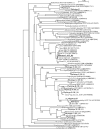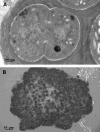Isolation of novel extreme-tolerant cyanobacteria from a rock-dwelling microbial community by using exposure to low Earth orbit
- PMID: 20154120
- PMCID: PMC2849240
- DOI: 10.1128/AEM.02547-09
Isolation of novel extreme-tolerant cyanobacteria from a rock-dwelling microbial community by using exposure to low Earth orbit
Abstract
Many cyanobacteria are known to tolerate environmental extremes. Motivated by an interest in selecting cyanobacteria for applications in space, we launched rocks from a limestone cliff in Beer, Devon, United Kingdom, containing an epilithic and endolithic rock-dwelling community of cyanobacteria into low Earth orbit (LEO) at a height of approximately 300 kilometers. The community was exposed for 10 days to isolate cyanobacteria that can survive exposure to the extreme radiation and desiccating conditions associated with space. Culture-independent (16S rRNA) and culture-dependent methods showed that the cyanobacterial community was composed of Pleurocapsales, Oscillatoriales, and Chroococcales. A single cyanobacterium, a previously uncharacterized extremophile, was isolated after exposure to LEO. We were able to isolate the cyanobacterium from the limestone cliff after exposing the rock-dwelling community to desiccation and vacuum (0.7 x 10(-3) kPa) in the laboratory. The ability of the organism to survive the conditions in space may be linked to the formation of dense colonies. These experiments show how extreme environmental conditions, including space, can be used to select for novel microorganisms. Furthermore, it improves our knowledge of environmental tolerances of extremophilic rock-dwelling cyanobacteria.
Figures




References
-
- Altschul, S. F., W. Gish, W. Miller, E. W. Myers, and D. J. Lipman. 1990. Basic local alignment search tool. J. Mol. Biol. 215:403-410. - PubMed
-
- Anagnostidis, K., and J. Komarek. 1990. Modern approach to the classification-system of Cyanophytes 5. Stigonematales. Archiv. Hydrobiol. 86:1-73.
-
- Bell, R. A. 1993. Cryptoendolithic algae of hot semiarid lands and deserts. J. Phycol. 29:133-139.
-
- Bruno, L., D. Billi, and P. Albertano. 2006. Genetic characterization of epilithic cyanobacteria and their associated bacteria. Geomicrobiol. J. 23:293-299.
Publication types
MeSH terms
Substances
Associated data
- Actions
- Actions
- Actions
- Actions
- Actions
- Actions
- Actions
- Actions
- Actions
- Actions
- Actions
- Actions
- Actions
- Actions
- Actions
- Actions
- Actions
- Actions
- Actions
- Actions
- Actions
- Actions
- Actions
- Actions
- Actions
- Actions
- Actions
- Actions
- Actions
- Actions
- Actions
- Actions
- Actions
- Actions
- Actions
- Actions
- Actions
- Actions
- Actions
- Actions
- Actions
- Actions
- Actions
- Actions
- Actions
- Actions
- Actions
- Actions
- Actions
- Actions
- Actions
- Actions
- Actions
- Actions
- Actions
- Actions
- Actions
- Actions
- Actions
- Actions
- Actions
- Actions
- Actions
- Actions
- Actions
- Actions
- Actions
- Actions
- Actions
- Actions
- Actions
- Actions
- Actions
- Actions
- Actions
- Actions
- Actions
- Actions
- Actions
- Actions
- Actions
- Actions
- Actions
- Actions
- Actions
- Actions
- Actions
- Actions
- Actions
- Actions
- Actions
- Actions
- Actions
LinkOut - more resources
Full Text Sources
Molecular Biology Databases

